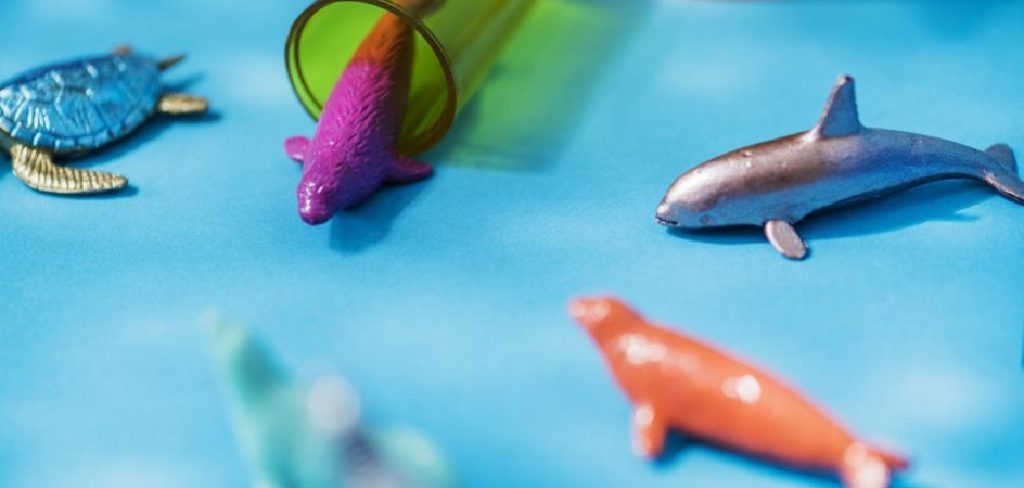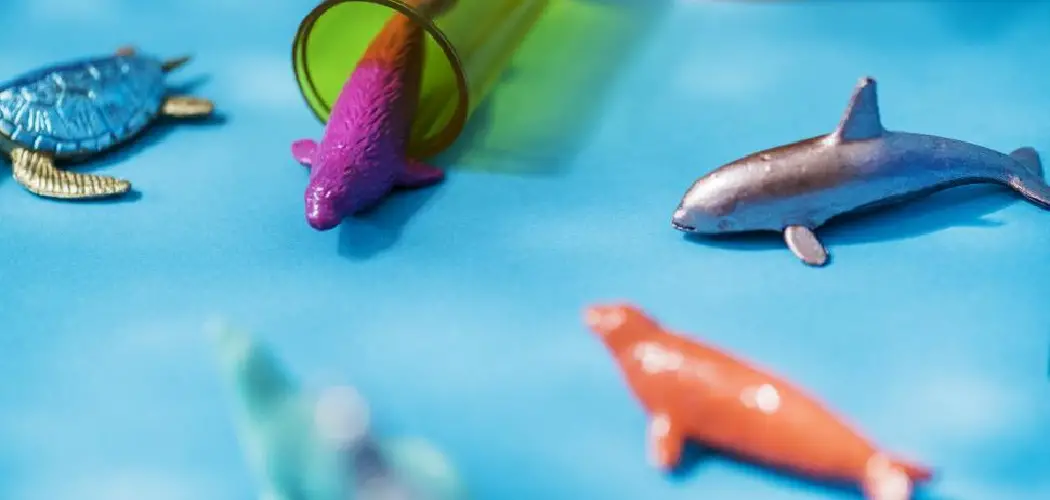To make fake water, mix clear hair gel with blue food coloring. This mixture will create a realistic-looking water-like substance.
Fake water can be helpful for various purposes such as for stage plays, photography, and special effects. It can be tricky to create something that looks realistic without using actual water. Fortunately, there are easy diy methods using simple household items.
The most common method is mixing clear hair gel with food coloring to create a water-like substance that mimics the actual appearance of water. This method is not only easy to make but also affordable. Additionally, you can adjust the amount of food coloring used to create different water tones, such as murky or clear water. Overall, creating fake water offers an affordable alternative to using actual water while still achieving the desired effect.

Gathering The Required Materials And Tools
Making fake water is a great way to create beautiful displays for events, theater productions, or even just for fun. You don’t have to be an expert to make fake water. With the right materials and tools, you can create realistic-looking fake water that will enhance the beauty of your project.
In this section, we will guide you through the process of gathering the required materials and tools to make fake water a success. Let’s dive in!
List Of Materials Needed
To make fake water, you will need the following materials:
- Resin or gel medium: Resin or gel medium will serve as your base for creating the fake water. Many different kinds of resin or gel mediums are available on the market, and you should select one that meets your specific project needs.
- Coloring agents: To create the perfect color of water, you might need coloring agents such as dyes, pigments, or alcohol inks. These coloring agents will provide the necessary depth and coloration to your fake water.
- Mixing cups: You need to mix resin or gel medium with the coloring agents. For this, you will need mixing cups. Choosing a set of cups with various sizes and shapes will provide you with greater mixing capacity and control.
- Stir sticks: Mix the resin and color agents with stir sticks to avoid air bubbles.
- Resin molds: You will need a mold for the water. Resin molds are readily available in various shapes and sizes. You need to consider the project requirements while selecting the right mold.
- Heat gun or torch: A heat gun or torch will help remove trapped air bubbles after pouring and will give a smooth finish to the product.
Now that you have gathered all your materials, let’s move on to the required tools for the job.
List Of Tools Needed
The following tools are needed to make fake water:
- Level surface: A large, level surface is essential for creating fake water. It will prevent resin or gel-medium from pooling and will help in better mixing.
- Gloves: Always wear disposable gloves while working with resin or gel medium. It might cause skin allergies or irritation when in contact with the skin.
- Respirator: The fumes from the resin or gel medium can be toxic, so wearing a respirator will help avoid inhalation toxicity. Always work in a well-ventilated area.
- Razor blade: A razor blade is needed for trimming edges and removing excess resin or gel medium after pouring.
- Small brush: A small brush will be handy to apply color agents in tricky spots.
- Measuring cups: Measuring cups are essential for the accurate measurement of resin, gel medium, and coloring agents.
- Scale: You might need a scale for a precise measurement of constituents, notably when using small quantities.
Now that we have discussed the materials and tools required let’s dive deeper into the process of making fake water in the next section.
Preparing The Resin And Pigment Mixture
Creating a fake water effect can be an exciting and challenging task. Making your own resin and pigment mixture is an essential step in achieving this effect. Here are the three simple steps to prepare the resin and pigment mixture for your project.
Step 1: Measure And Mix The Resin With Hardener
The first step in creating a resin and pigment mixture is to use a resin and hardener kit. Measure the amount of resin and hardener you need for your project carefully. A suitable ratio of resin to hardener is 1:1, but make sure to read the instructions carefully.
Overusing one or the other could ruin the mixture.
Once you have measured the appropriate amount of resin and hardener, pour the resin into a mixing container and add the hardener. Mix both components thoroughly for at least two minutes; the mixture should be clear, with no cloudy spots.
Ensure that you scrape the bottom and sides of the mixing container as you mix.
Step 2: Add The Desired Pigment And Mix Well
Once you have mixed the resin and hardener, you can add pigment to your mixture. Be sure to use the desired amount of pigment and mix well. You can add multiple colors if desired.
Step 3: Check For Air Bubbles And Remove
Once you have added your pigment, take a moment to check your mixture for air bubbles. If you see any bubbles, use a propane torch or a heat gun to remove them. Hold the heat source 2-3 inches above the surface of the mixture and pass it gently and quickly to avoid releasing more bubbles.
Make sure to keep the heat source moving.
These steps are basic but essential when preparing resin and pigment mixtures. Take your time when mixing, following each step accurately, and be prepared to experiment with the pigment ratio to achieve the desired effect. Finally, remember to handle your mixture with care, and your project will come out looking fantastic.
Creating The Illusion Of Depth In The Water
Have you ever wondered how to make fake water for your art project or aquarium? It’s easier than you might think! To really make the water look convincing, you need to create the illusion of depth. In this section, we’ll go through the steps to achieve this effect.
Step 4: Pour The Resin Mixture Into A Silicone Mold
The first step is to create a base layer of tinted resin. Choose a color that closely matches the water you’re trying to replicate, such as blue or green. Then, pour the resin mixture into the silicone mold you’ve chosen.
Make sure that the mold is clean and dry before you pour in the mixture.
Step 5: Create Ripples And Waves
Next, you’ll want to create ripples and waves to give the water texture. You can do this by using a toothpick or other tool to carefully create small ripples on the surface of the resin. Don’t go overboard with this step – less is often more when it comes to creating a natural-looking water effect.
Step 6: Add The Illusion Of Depth With Layers Of Tinted Resin
To really make the water look three-dimensional, you’ll need to add layers of tinted resin. You can achieve different depths by making the layers thicker or thinner in certain areas. Start by adding a darker tint to the resin mixture and pour it into the mold.
Once that layer has dried, add another layer with a slightly lighter tint. Repeat this process until you have the desired level of depth.
- Add darker tinted resin first, then gradually make it lighter in each layer.
- Use different shades of blue or green to create a natural-looking effect.
- Add more layers to areas that need more depth, such as near the bottom of the mold.
And there you have it – fake water that looks like the real thing! With these simple steps and a little creativity, you can create stunning water effects for your next project. Try experimenting with different colors, textures, and layering techniques to create the perfect water effect for your needs.
Adding Realism With Small Details
Water is an essential element in various types of art, especially for creating realistic landscapes or underwater scenes. Creating fake water requires attention to small details to make it appear more realistic.
Step 7: Create Foam And Bubbles With Cotton
To create the foam and bubbles on top of the water, you will need some cotton. Here’s how to do it:
- Pull apart a small amount of cotton into small pieces.
- Apply a small amount of white paint to each piece of cotton, ensuring that it is applied unevenly to create a realistic appearance.
- Arrange the cotton pieces on top of the water in various areas.
- Attach and blend the cotton pieces with the fake water material using a brush.
Step 8: Enhance The Appearance Of Water With Gloss Varnish
Method of enhancing water using gloss varnish:
- Using a brush, apply a thin layer of gloss varnish over the entire surface of the fake water material.
- Wait for it to dry completely.
Adding gloss varnish gives the water surface a smooth appearance and highlights the other details of the water.
Small details make a significant difference in creating realistic fake water. Using cotton to create foam and bubbles and enhancing the appearance of water with gloss varnish are two effective ways to add more depth to your artwork.
Frequently Asked Questions For How To Make Fake Water
How Do You Make Fake Water For A Science Project?
Combine 4 cups of corn syrup and 1 cup of baby oil. Stir gently until they form a homogeneous mixture. Adjust color by adding food coloring or tint from visual properties. Make sure to use in a sturdy, waterproof container.
What Materials Do I Need To Make Fake Water?
You need corn syrup, baby oil, a waterproof container, and food coloring. Adjust the measurements based on the amount you need, and make sure you have a clear understanding of the instructions to follow.
Can Fake Water Be Used As A Substitute For Real Water?
Fake water can be used as a substitute for real water as a visual aid. It can be used in science projects or displays where real water isn’t practical or sustainable to use. make sure to use enough fake water to cover the base of your container and any objects placed inside it.
How Long Does Fake Water Last?
Fake water can last for a very long time if you store it properly. Keeping it away from direct sunlight and heat sources is key, as exposure can result in discoloration and a change in the thickness. whenever you are not using it, keep the fake water in an airtight container to prevent evaporation.
Is It Safe To Use Fake Water?
Fake water mixture made of corn syrup and baby oil should not be consumed. While generally safe to use, avoid contact with eyes or direct skin exposure, as it can be sticky and hard to clean off. Keep it out of reach of pets and children.
Conclusion
After following the steps outlined in this article, it’s clear that making fake water is a simple yet very effective skill. Whether you’re creating fake water for a movie or theatre set, or simply looking for a fun craft project, this diy recipe is a great place to start.
By using a combination of clear silicone and resin, you can create a durable and realistic-looking water effect that can withstand the test of time. Don’t be afraid to experiment with different dyes and sparkles to achieve a bespoke look.
With a bit of creativity and practice, you can soon become an expert at creating fake water that will fool even the most discerning of audiences. So why not give it a try and see what kind of beautiful creations you can come up with?

